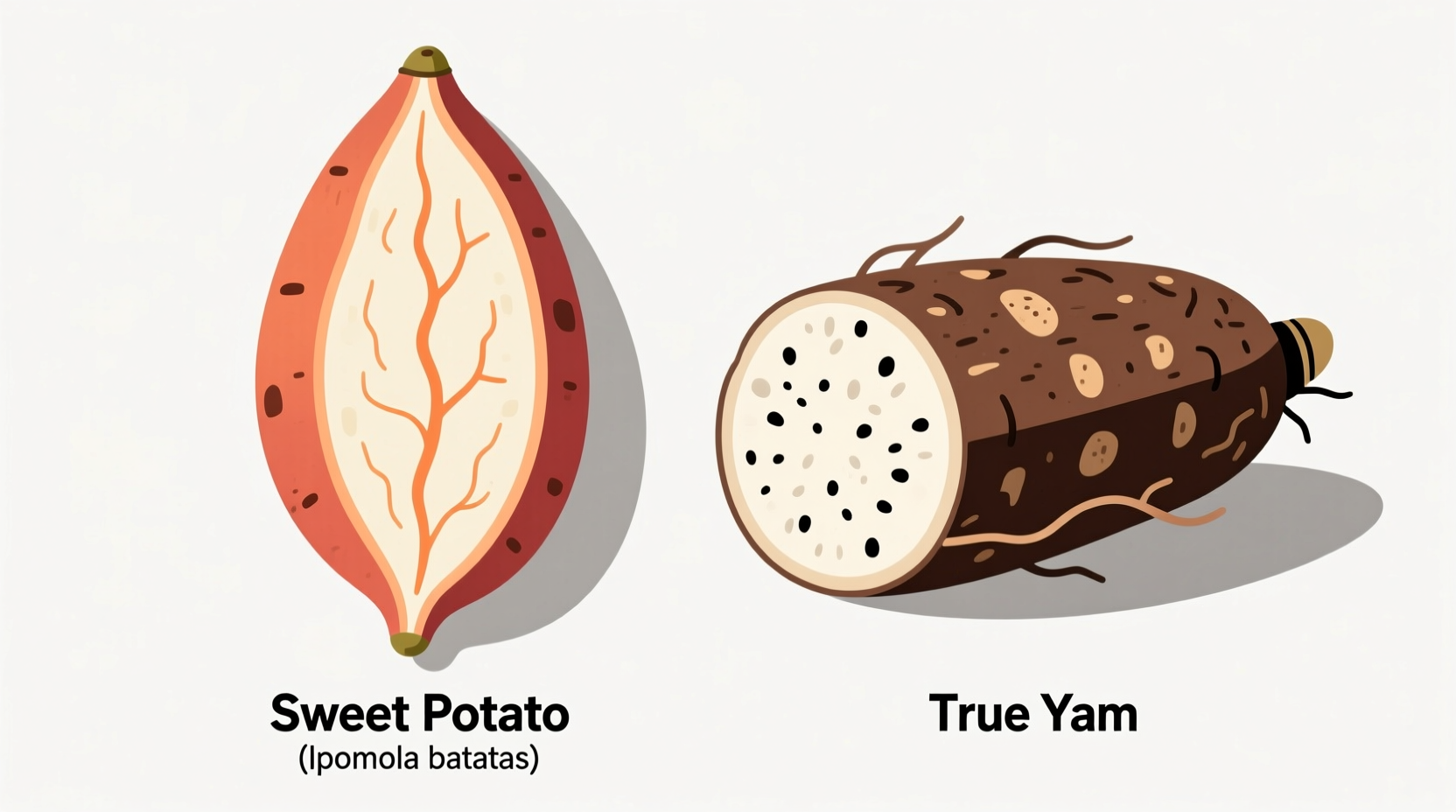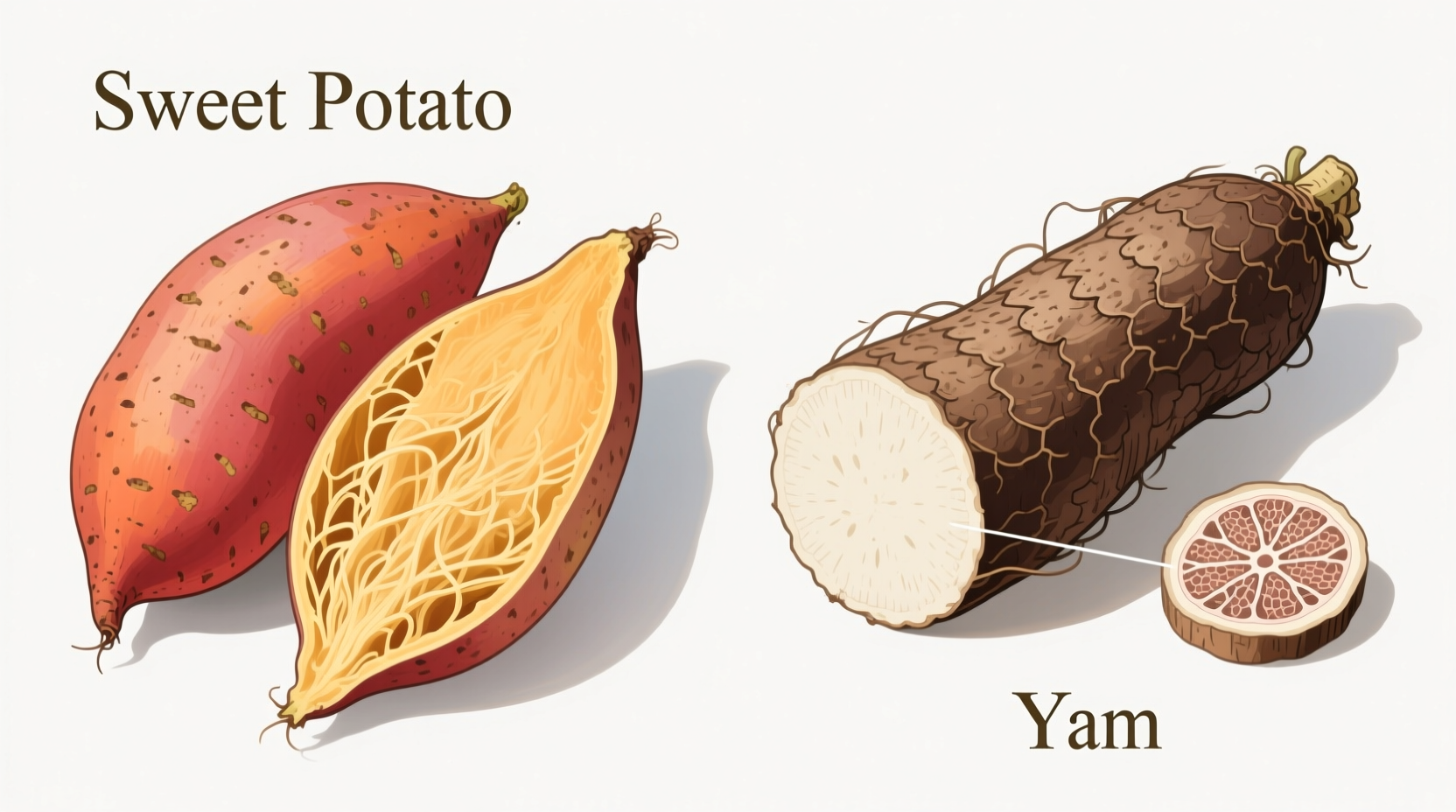No, sweet potatoes and yams are not the same. Despite common grocery store labeling, these are two completely different root vegetables with distinct botanical origins, nutritional profiles, and culinary properties. Understanding the difference ensures you get the right ingredient for your recipes and accurate nutritional information.
Ever stood in the produce aisle confused by labels calling orange-fleshed sweet potatoes "yams"? You're not alone. This widespread mislabeling has created decades of confusion, but the truth is simple: sweet potatoes (Ipomoea batatas) and true yams (Dioscorea species) belong to entirely different plant families. Let's clear up this common culinary misconception once and for all.
The Historical Mix-Up: How Confusion Took Root
The sweet potato-yam confusion dates back to early 20th century America. When soft, orange-fleshed varieties of sweet potatoes were introduced to distinguish them from the firmer, yellow-fleshed varieties already popular, marketers borrowed the African word "nyami" (meaning "to eat") to create "yam." This was purely a marketing tactic to differentiate the varieties, not a botanical classification. The U.S. Department of Agriculture now requires that any product labeled as "yam" must also include the term "sweet potato" to prevent consumer confusion.
Botanical Breakdown: Scientific Classification Differences
Sweet potatoes belong to the morning glory family (Convolvulaceae), while true yams are part of the Dioscoreaceae family. This fundamental botanical difference explains why they have such distinct characteristics:
| Characteristic | Sweet Potato | True Yam |
|---|---|---|
| Scientific Name | Ipomoea batatas | Dioscorea species |
| Native Region | Central and South America | Africa, Asia, Caribbean |
| Texture | Moist, tender when cooked | Dry, starchy, sometimes fibrous |
| Skin Color | Thin, ranges from beige to copper | Thick, bark-like, dark brown/black |
| Flesh Color | Orange, white, purple | White, yellow, pink |
| Nutritional Profile | High in vitamin A (beta-carotene) | Higher in carbohydrates, lower in vitamins |
How to Identify Them in Your Grocery Store
True yams are rarely found in standard American grocery stores—they're primarily sold in international markets specializing in African, Asian, or Caribbean foods. What's labeled as "yams" in most supermarkets are actually sweet potatoes. Here's how to tell what you're really buying:
- Orange-fleshed varieties (often mislabeled as yams): These are sweet potatoes with higher sugar content and moisture. Look for varieties like Jewel, Garnet, or Beauregard.
- White or pale yellow varieties: These are firm sweet potatoes, sometimes correctly labeled as "sweet potatoes" but occasionally still called "yams" in error.
- True yams: Have rough, almost bark-like skin, are cylindrical in shape, and can grow extremely large (some varieties reach 100+ pounds!). Their flesh is usually white or yellow and much starchier than sweet potatoes.

Nutritional Comparison: What Your Body Actually Gets
According to USDA FoodData Central, a medium sweet potato (130g) provides 103 calories, 24g carbohydrates, and a staggering 438% of your daily vitamin A needs. True yams, by comparison, contain more carbohydrates (about 27g per 100g) but significantly less vitamin A. Sweet potatoes' vibrant orange color comes from beta-carotene, which your body converts to vitamin A—a nutrient virtually absent in true yams.
The confusion matters nutritionally: if you're choosing "yams" for their vitamin A content (common in dietary planning), you're actually getting sweet potatoes. Conversely, if you're avoiding high-glycemic foods, sweet potatoes have a lower glycemic index than true yams, making them a better choice for blood sugar management.
Culinary Applications: When Substitution Matters
While you can sometimes substitute one for the other, understanding their cooking properties prevents recipe disasters:
- Sweet potatoes become tender and moist when cooked, making them ideal for mashing, roasting, or using in pies. Their natural sweetness pairs well with both savory and sweet applications.
- True yams maintain a firmer, starchier texture even when cooked, behaving more like potatoes. They're commonly boiled, fried, or pounded into fufu in African and Caribbean cuisines.
Professional chefs in Latin American and Caribbean kitchens (where both ingredients feature prominently) emphasize that substituting one for the other dramatically alters texture and flavor profiles. Maya Gonzalez, a Latin American cuisine specialist with field research across the Americas, notes: "In traditional Puerto Rican pasteles, using sweet potato instead of true yam creates a completely different texture that locals would immediately recognize as inauthentic. Understanding these distinctions preserves culinary heritage."
Practical Shopping Guide: Getting What You Want
Follow these tips to ensure you're buying the right root vegetable:
- Read labels carefully: Look for specific variety names rather than relying on "yam" labeling
- Examine the skin: True yams have thick, rough, almost bark-like skin; sweet potatoes have thinner, smoother skin
- Check the shape: Sweet potatoes are tapered at both ends; true yams are more cylindrical
- Ask store staff: Many grocery employees don't know the difference—show them this guide!
- For authentic recipes: Seek specialty markets for true yams; standard supermarkets primarily carry sweet potatoes
Remember that purple-fleshed sweet potatoes (like Okinawan varieties) are still sweet potatoes, not yams—they just contain different anthocyanin pigments. These offer unique nutritional benefits with high antioxidant levels, according to research from the New Jersey Agricultural Experiment Station.
Why This Distinction Matters Beyond the Kitchen
The sweet potato-yam confusion isn't just culinary—it has economic and cultural implications. In Africa, where true yams are a staple crop with deep cultural significance, the mislabeling perpetuates agricultural misconceptions. The International Institute of Tropical Agriculture reports that yams represent a $10 billion industry across West Africa, where they feature in traditional ceremonies and serve as currency in some communities. Recognizing the difference shows respect for these cultural traditions while ensuring accurate nutritional information for consumers worldwide.











 浙公网安备
33010002000092号
浙公网安备
33010002000092号 浙B2-20120091-4
浙B2-20120091-4